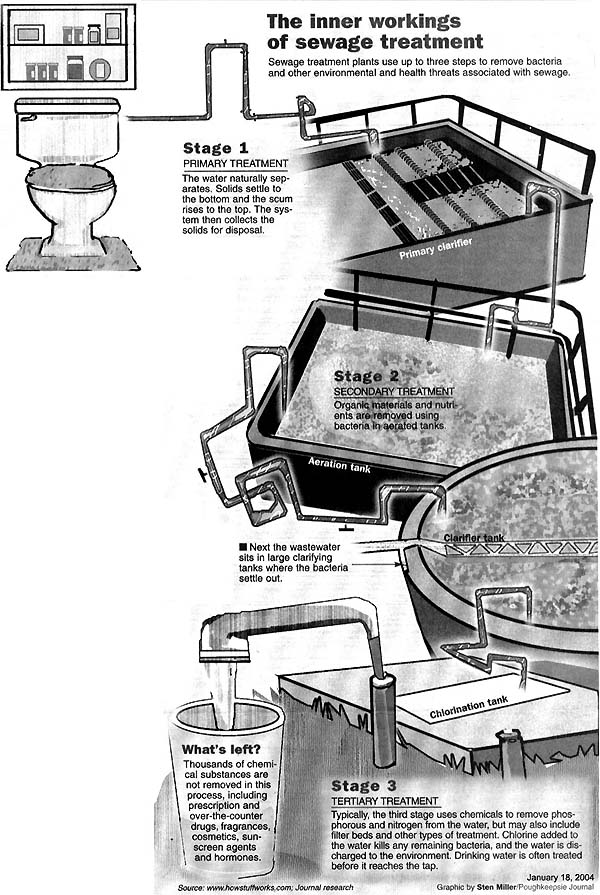
January 18, 2004
Our Environment: Eat, drink and be wary
Chemicals often linger in water after treatment
By Brian Buckley
For the Poughkeepsie Journal

Our Environment: Eat, drink and be wary
Chemicals often linger in water after treatment
By Brian Buckley
For the Poughkeepsie Journal
It's a common bit of wisdom -- You are what you eat.
It's just as true that you are what you drink, or, as recent studies are telling us -- you drink what you are.
We have become a complicated society that relies heavily on technological conveniences to keep us comfortable.
Fire retardants make us safe and plastics are easy to use and cheap. Fragrances and flavors enrich our sense of smell or cover up unpleasant odors. And the medicines and food additives we consume every day enrich our quality of life and keep us healthy.
But they also end up in our water.
All these chemicals -- antidepressants, caffeine, birth-control pills, deodorants and thousands of other chemicals -- are released in small amounts from millions of toilets and drains from homes all over the country. Neither septic systems, sewage treatment plants, wells nor drinking water treatment plants remove all of them.
Scientists refer to these chemical compounds in a number of ways -- tentatively identified compounds (TICs), pharmaceuticals and personal care products (PPCPs) or emerging contaminants.

Most pose no hazard
At the very low levels they are found, most are probably not hazardous to our health.
Some are in greater use today than 10 or 20 years ago, as new drugs are developed and used by more and more people every year. But it is likely many of these compounds have always been in the water. Until recently, we never looked for them.
In the late 1990s, that changed. The U.S. Geologic Survey has conducted nationwide surveys to begin studying these chemicals, and New Jersey Department of Environmental Protection and others have done studies of these "non-traditional" contaminants.
Regular water testing at drinking water treatment plants is done on regulated pollutants, such as heavy metals and many industrial chemicals, to make sure the water you drink does not contain unsafe levels of these contaminants. Individual privately-owned wells do not have this protection.
Most of the compounds measured in these new studies are not regulated either because they were not believed to cause poor health effects or because no one knew they were there.
New testing techniques that allow scientists to detect minute concentrations of these chemicals, and the act of looking itself revealed that these chemicals are in many water supplies.
Scientists suspected compounds such as caffeine and man-made estrogens would be found in water.
They were not regulated, either because no one knew how concentrated they were in water supplies, or because regulators assumed if it was OK to consume at high levels, it should be OK to consume at the very low levels found in the water.
On the other hand, until these studies were done, no one knew compounds such as hexadecanoic acid -- used in the manufacture of soaps among other things -- or the food additive BHA would be found in so many water supplies.
Bacteria could be affected
Many studies about the effects these chemicals have on the environment and human health have focused on the potential for antibiotics released in the waste stream to increase bacterial resistance -- which could spur strains of bacteria to evolve faster to withstand our most powerful drugs.
Other avenues of research have identified hormones that change the sex characteristics of fish.
While it is unlikely most of these compounds will ever cause a risk to human health, most people would probably prefer not to have the bonus of a little extra caffeine every day in their finished tap water.
In addition, the question remains how drinking small amounts of many different compounds over a lifetime could affect people's health, or how the different chemicals could react with each other.
Water "cleaning" strategies used by drinking water treatment plants are aimed at removing the regulated compounds.
For example, most of the regulated compounds are volatile and can be removed by mixing water vigorously with air so the chemicals dissipate.
The compounds measured as a part of these studies would not be removed by air stripping, and some of these compounds have been detected in tap water, demonstrating the current cleanup methods do not get everything.
A difficult question
Activated charcoal filtering should remove most of these compounds -- a much more expensive treatment method than other drinking water treatments. Adding a charcoal system also adds cost to every gallon of water processed.
When the question is human health, the answer is generally "spare no expense," but when the answer to a human health question is unknown, many people will question whether it is worth an additional expense when most of the water that comes into your home is not used to drink.
How much are you willing to pay per toilet flush?
---
Brian Buckley is an analytical chemist and the executive director of labs and facilities at the Environmental and Occupational Health Sciences Institute at Rutgers University in Piscataway, NJ.
---
On the Web
- The Environmental Protection Agency's Web site for "Pharmaceuticals and Personal Care Products (PPCPs) as Environmental Pollutants": www.epa.gov/nerlesd1/chemistry/pharma/index.htm
- The U.S. Geologic Survey's Web site for its Toxic Substances Hydrology Program: http://toxics.usgs.gov
| Watershed Home | Media Menu |